Collection: PHUANG MALAI - MOTHER'S DAY & VIP GIFTS
Why give a Phuang Malai for Mother's Day in Thai culture?
In the Land of Smiles, the tradition of gifting a Phuang Malai for our Mom's Day symbolizes the love, gratitude, and appreciation that children feel for their mothers. These exquisite floral garlands, deeply rooted in Thai culture, have been used for centuries in religious and ceremonial events.
In this article, we'll uncover the origins and significance of this flower ornament and its role in Mother's Day celebrations in Thailand.
Among a variety of choices, Malai cuty is the symbol of simplicity and love and Malai Grace represents good health and protection of our mother.
Historical Background: Tracing the Roots of Mother's Day and Phuang Malai
A Royal Connection: Queen Savang Vadhana, Queen Sirikit, and Mother's Day
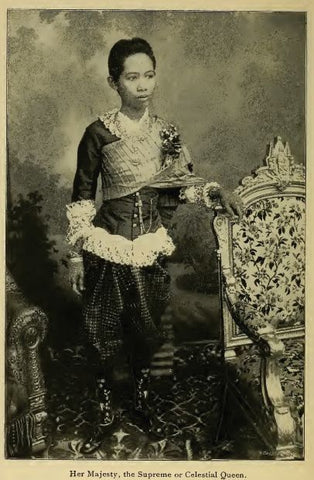
Credit: Pinterest
The Matriarchal Celebration in Thailand traces its roots back to the reign of King Chulalongkorn (Rama V) in the late 19th and early 20th centuries. The celebration gained prominence due to the influence of Queen Savang Vadhana, the grandmother of the current king, King Vajiralongkorn (Rama X).
Queen Savang Vadhana played a vital role in shaping modern Thailand by promoting education, healthcare, and various social reforms.
She was highly respected and revered by the Thai people, leading to the establishment of a special day to honor her and all mothers.
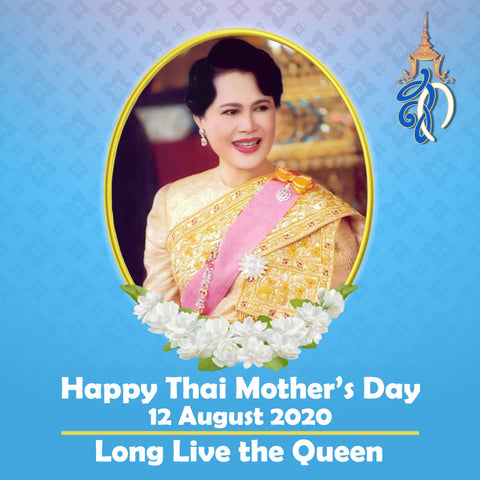
But this day, as we know it today, took on a more formal and widespread significance during the reign of King Bhumibol Adulyadej (Rama IX). His wife, Queen Sirikit, was greatly admired for her dedication to social causes, and her birthday on August 12th became the official date for Mother's Day in Thailand.
The Thai people celebrate this occasion with great enthusiasm and reverence, honoring their own mothers alongside the beloved Queen.
The Evolution of Phuang Malai as a Mother's Day Gift
The connection between Thai culture and this garland made of fresh flowers can be traced back centuries.
Phuang Malai has its origins in the Hindu religion, which influenced many aspects of Thai culture, including its art, architecture, and rituals. The practice of offering floral garlands as a symbol of respect and reverence has long been a part of Thai tradition.
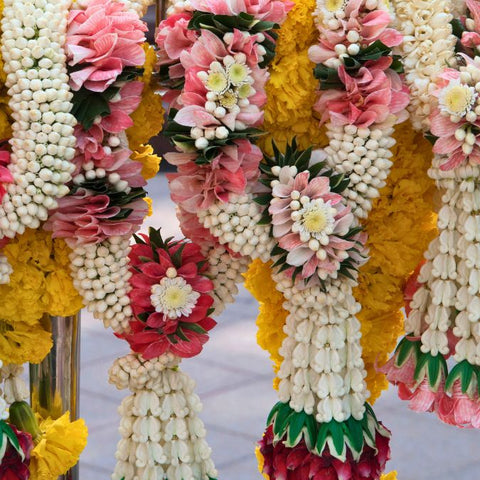
Over time, this ornament became an essential part of various religious, social, and cultural events in Thailand, including weddings, Father’s Day, and welcoming ceremonies.
The art of creating Phuang Malai developed alongside the growth of Thai culture, with skilled artisans crafting intricate and beautiful designs. These floral garlands became not only a symbol of respect but also an expression of aesthetic beauty and creativity.
As this tribute day gained popularity and prominence in Thai society, it was only natural for this cultural design to become the perfect gift for mothers.
The garlands' beauty, fragrance, and deep cultural significance make them a heartfelt and meaningful way to honor and appreciate the love and sacrifices of mothers throughout Thailand.
Meaning of the Malai: A Gift that Embodies Love and Devotion for a Mom
Phuang Malai, with its intricate designs and fragrant blossoms, is considered an ideal gift for mothers due to its deep symbolism of love, respect, and devotion.
It’s pleasing aesthetics and delightful scents create an incomparable gift-giving experience. The fragrance of the perfume would be like a reminder of the sweet presence of your mother in our childhood life, while the colors represent the joy and happiness she brought us.
By gifting a Malai on Mother's Day, children can express their gratitude and in a meaningful and heartfelt way.
The garland not only serves as a beautiful present but also as a symbol of the unbreakable bond between a mother and her child, making it an unforgettable and deeply cherished gift.
The Importance of Updating Tradition to Protect Culture: Rethinking Phuang Malai with Nicha's Unique Approach
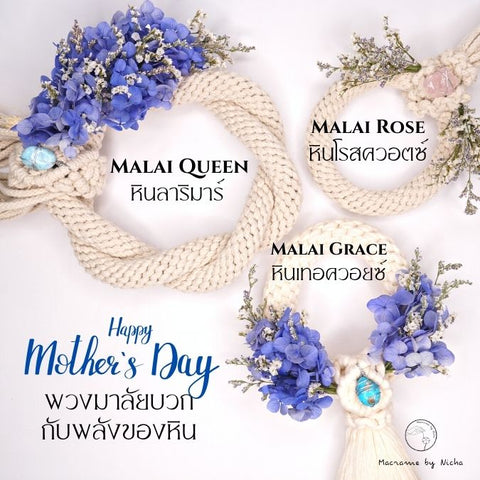
In today's fast-paced world, it is essential to update and adapt to changes to protect our culture and traditions.
Nicha, a talented Thai artist, understands the importance of preserving the tradition of the Thai flower art while also adding a modern touch to it. By rethinking its conception in her own way, she has created stunning garlands that will stand the test of time.
Nicha's approach is refreshing and innovative. Instead of using fresh flowers, which wilt and fade quickly, she opts for materials such as cotton that allow the garlands to last forever.
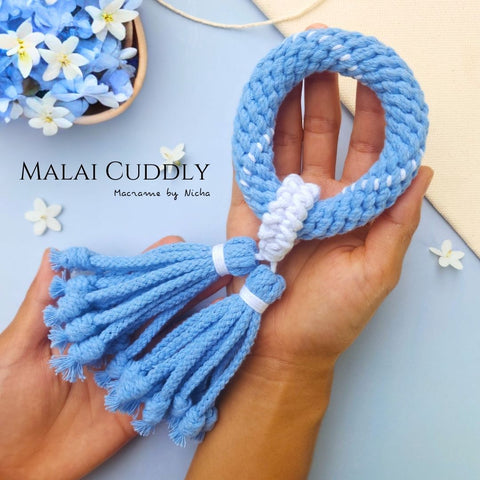
By adding dried natural flowers and semi-precious stones, Nicha creates a more profound meaning and emotional value to her Phuang Malai.
Her artistic flair and modern materials provide a new dimension to traditional garlands, making them not only aesthetically pleasing but also long-lasting and symbolic.
The Traditional Phuang Malai vs Nicha's Redefinition with Cotton, Natural Flowers, and Semi-Precious Stones
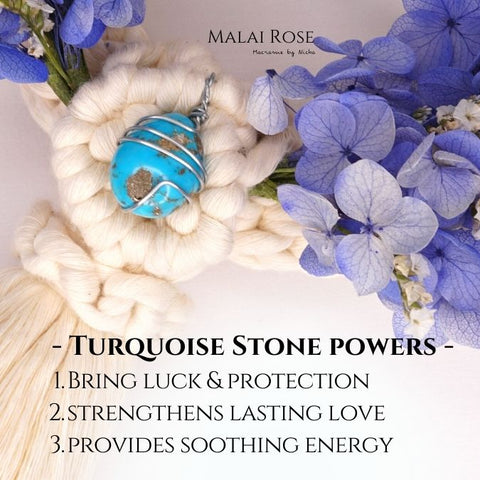
When comparing Nicha's work to traditional garlands, it is clear that she has elevated the craft to new heights.
Her garlands offer personalization options, and the materials used give them a unique texture and feel. She add a new layer of depth to the tradition, allowing people to express their emotions and love for their mothers in a more modern and meaningful way.
Nicha's innovative approach is a step forward in preserving our cultural heritage. Her use of long-lasting materials and her creative interpretations of the garlands give us a new perspective on this cherished tradition.
It is vital to update and adapt our traditions while also honoring their roots to ensure they remain relevant and valued for generations to come.

In conclusion, the tradition of gifting a Phuang Malai for Mother's Day in Thailand is deeply rooted in the country's culture and history. The significance of this gift lies in its symbolism of love, gratitude, and appreciation for mothers.
As society and culture evolve, it is crucial to update and adapt traditions while still honoring their roots. Nicha's innovative approach is a perfect example of how we can preserve and enhance our cultural heritage.
By rethinking Thai flower art with new materials and adding a modern touch to the craft, Nicha has elevated this cherished tradition to new heights.
It is important to celebrate our Mom's Day with a gift that not only honors our traditions but also reflects our modern sensibilities, and Nicha's Phuang Malai is the perfect choice.
-
MALAI PURITY PETITE - พวงมาลัยความบริสุทธิ์ - พวงมาลัยวันแม่ - งานแต่งงาน
![Phuang Malai - Macrame by Nicha - Petite Malai Purity - พวงมาลัยความบริสุทธิ์ - ของขวัญ - พวงมาลัยกอด Hands]()
- Regular price
- 1,090.00 ฿
- Sale price
- 1,090.00 ฿
- Regular price
-
- Unit price
- per
Sold out -
MALAI SUPREME PURITY - Symbol of Wisdom - Premium Phuang Malai - VIP Gift - Customer Gift
![Phuang Malai 2023 - VIP Gifts GWP - Macrame by Nicha - Malai Purity- พวงมาลัยความบริสุทธิ์ - ของขวัญ VIP -พวงมาลัยวันแม่ Hand]()
- Regular price
- 2,290.00 ฿
- Sale price
- 2,290.00 ฿
- Regular price
-
- Unit price
- per
Sold out -
MALAI GRACE - Phuang Malai - Wish Peace and good health - Thailand Thank you gifts, mother's day or wedding
![Phuang Malai - Macrame by Nicha - Malai Grace - พวงมาลัยแห่งความสง่างาม - ของขวัญ - พวงมาลัยกอด Hands]()
- Regular price
- 2,490.00 ฿
- Sale price
- 2,490.00 ฿
- Regular price
-
- Unit price
- per
Sold out -
MALAI CUTY - Phuang Malai - Symbol of simplicity - A 100% guaranteed gift - Thailand Thank you gifts, mother's day or wedding
![Macrame by Nicha - Phuang Malai Thailand - MALAI CUTY – พวงมาลัยคิวตี้ - พวงมาลัยวันแม่ - ของขวัญ]()
- Regular price
- 890.00 ฿
- Sale price
- 890.00 ฿
- Regular price
-
- Unit price
- per
Sold out -
MALAI CUTY - Phuang Malai - Symbol of simplicity - A 100% guaranteed gift - Thailand Thank you gifts, mother's day or wedding
![]()
- Regular price
- 490.00 ฿
- Sale price
- 490.00 ฿
- Regular price
-
- Unit price
- per
Sold out -
MALAI PRESTIGE - VIP MALAI - GIFT OF SUCCESS & COLLABORATION - Premium Phuang Malai - VIP Gift - Customer Gift
![MALAI PRESTIGE - VIP MALAI - พวงมาลัยทองคำ - ความสำเร็จและความร่ำรวย - ของขวัญVIP Hand]()
- Regular price
- 3,090.00 ฿
- Sale price
- 3,090.00 ฿
- Regular price
-
- Unit price
- per
Sold out -
MALAI SWEETY – Symbol of Gratitude - A 100% guaranteed gift - Thailand Thank you gifts, mother's day or wedding
![Phuang Malai - Macrame by Nicha - Malai Sweety - ของขวัญ - พวงมาลัยวันแม่]()
- Regular price
- 790.00 ฿
- Sale price
- 790.00 ฿
- Regular price
-
- Unit price
- per
Sold out -
MALAI CHAAD - The Phuang Malai of the Nation - Premium Phuang Malai - VIP Gift - Customer Gift
![MALAI CHAAD - VIP MALAI - พวงมาลัยความบริสุทธิ์ - ของขวัญVIP - พวงมาลัยวันแม่ - พวงมาลัยทางการทูต hand]()
- Regular price
- 2,690.00 ฿
- Sale price
- 2,690.00 ฿
- Regular price
-
- Unit price
- per
Sold out -
MALAI DRAGON - Symbol of Professional Success - Premium Phuang Malai - VIP Gift - Customer Gift
![1 - Malai Golden Dragon - พวงมาลัยมังกรทอง - ตรุษจีน 2024 - Chinese New Year 2024 - Macrame by Nicha]()
- Regular price
- 1,490.00 ฿
- Sale price
- 1,490.00 ฿
- Regular price
-
- Unit price
- per
Sold out -
MALAI FLOWERS - Phuang Malai - Symbol of femininity and tenderness - Thailand Thank you gifts, mother's day or wedding
![Macrame by Nicha - Phuang Malai Thailand - MALAI FLOWERS – พวงมาลัยด้วยช่อดอกไม้ - พวงมาลัยวันแม่ - งานแต่งงาน – ของขวัญ3]()
- Regular price
- 1,090.00 ฿
- Sale price
- 1,090.00 ฿
- Regular price
-
- Unit price
- per
Sold out -
DIPLOMATIC MALAI - Phuang Malai for Officials and VIPs - Premium Gift
![Phuang Malai Premium - Diplomatic Malai - Malai Canada, Singapor, Japan - พวงมาลัยทางการทูต - พวงมาลัย - Macrame by Nicha hand]()
- Regular price
- 2,690.00 ฿
- Sale price
- 2,690.00 ฿
- Regular price
-
- Unit price
- per
Sold out -
POP KHRUANG KWAEN COLLECTION - THAI ELEPHANT NET - ELEPHANT ADORNEMENT - THAI HOME DECORATION - INTERIOR DESIGN
![POP KHRUANG KWAEN COLLECTION - THAI ELEPHANT NET - ELEPHANT ADORNEMENT - THAI HOME DECORATION - INTERIOR DESIGN - เครื่องแขวนไทย - Macrame by Nicha - ตาข่ายหน้าช้าง]()
- Regular price
- 2,900.00 ฿
- Sale price
- 2,900.00 ฿
- Regular price
-
- Unit price
- per
Sold out -
THE CROCODILE FRAGRANCE - กลิ่นจระเข้ - KHRUANG KWAEN - เครื่องแขวนไทย
![THE CROCODILE FRAGRANCE - กลิ่นจระเข้ - KHRUANG KWAEN - เครื่องแขวนไทย - Product presentation - Tale - Macrame By Nicha - Champa flowers]()
- Regular price
- 2,590.00 ฿
- Sale price
- 2,590.00 ฿
- Regular price
-
- Unit price
- per
Sold out -
THE SIAMESE SUNBEAM - รัตนาภรณ์ไทย - KHRUANG KWAEN CHANDELIER - โคมระย้าไทย
![THE NEW AGE OF Khruang Kwaen TCDC Exhibition June-July 2023]()
- Regular price
- 11,900.00 ฿
- Sale price
- 11,900.00 ฿
- Regular price
-
13,900.00 ฿ - Unit price
- per
Sold out -
MALAI CUDDLY – Symbol of Tenderness - A 100% guaranteed gift - Thailand Thank you gifts, mother's day or wedding
![Phuang Malai - พวงมาลัยวันแม่ - Macrame by Nicha - Malai Cuddly - ของขวัญ - พวงมาลัยกอด]()
- Regular price
- 790.00 ฿
- Sale price
- 790.00 ฿
- Regular price
-
- Unit price
- per
Sold out -
MODERN KHRUANG KWEN + Fresh Flowers
![]()
- Regular price
- 1,990.00 ฿
- Sale price
- 1,990.00 ฿
- Regular price
-
- Unit price
- per
Sold out -
THE SCENT OF A KINGDOM - กลิ่นหอมแห่งอาณาจักร - KHRUANG KWAEN CHANDELIER - เครื่องแขวน-โคมระย้า
![SCENT OF A KINGDOM - กลิ่นหอมแห่งอาณาจักร - KHRUANG KWAEN CHANDELIER - เครื่องแขวน-โคมระย้า - Product presentation -Macrame By Nicha]()
- Regular price
- 10,900.00 ฿
- Sale price
- 10,900.00 ฿
- Regular price
-
- Unit price
- per
Sold out -
MALAI ROSE QUARTZ - Phuang Malai - Wish peace and unconditional love - Thailand Thank you gifts, mother's day or wedding
![Macrame by Nicha - Phuang Malai Thailand - MALAI ROSE QUARTZ – พวงมาลัยหินโรสควอตซ์ - พวงมาลัยวันแม่ - ของขวัญ]()
- Regular price
- 1,690.00 ฿
- Sale price
- 1,690.00 ฿
- Regular price
-
- Unit price
- per
Sold out -
MALAI JAIDEE - TEACHER'S DAY - PHUANG MALAI WAI KRU - PUPIL & STUDENTS GRATITUDE
![MALAI JAIDEE - พวงมาลัยใจดี - พวงมาลัยไหว้ครู - Macrame by Nicha]()
- Regular price
- 990.00 ฿
- Sale price
- 990.00 ฿
- Regular price
-
- Unit price
- per
Sold out
FAQ ABOUT OUR PHUANG MALAI
- Choosing a selection results Shipping calculated at checkout.n a full page refresh.
- Press the space key then arrow keys to make a selection.




















